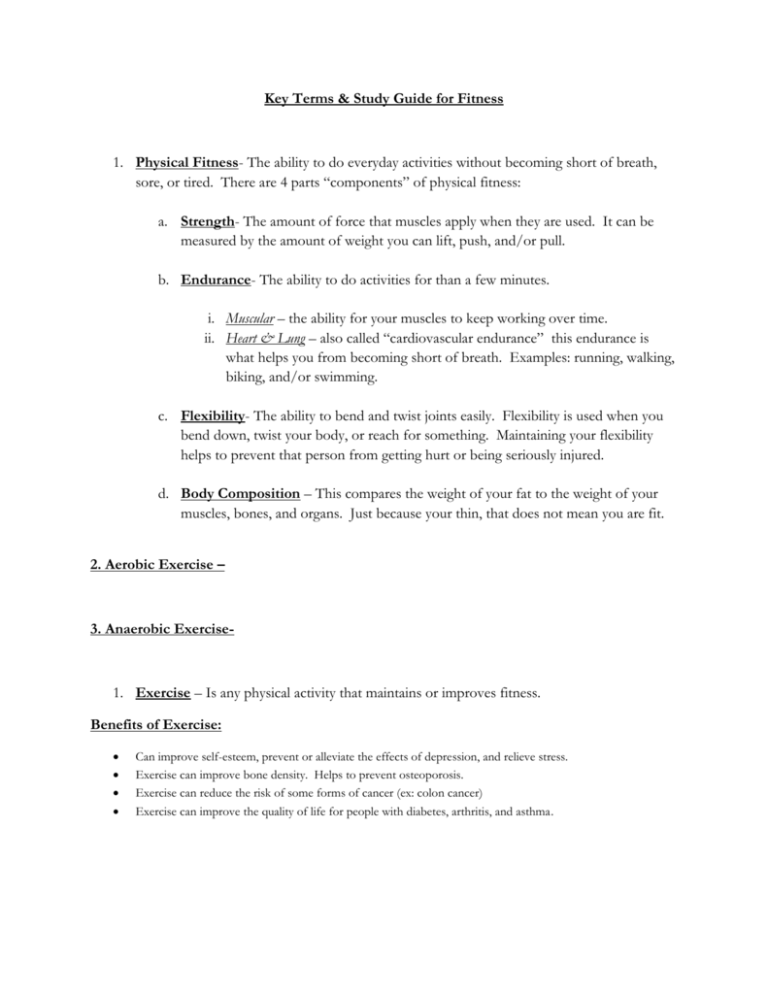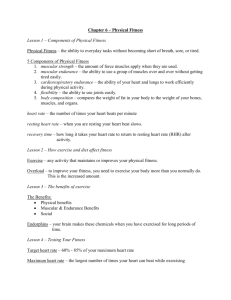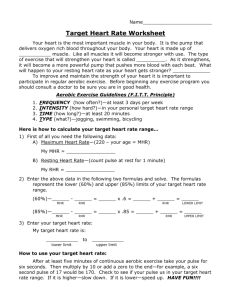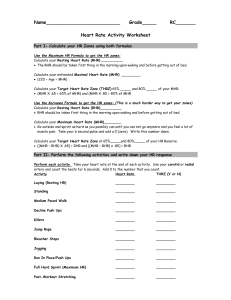Fitness Center Study Guide - Wood-Ridge School District / Homepage
advertisement

Key Terms & Study Guide for Fitness 1. Physical Fitness- The ability to do everyday activities without becoming short of breath, sore, or tired. There are 4 parts “components” of physical fitness: a. Strength- The amount of force that muscles apply when they are used. It can be measured by the amount of weight you can lift, push, and/or pull. b. Endurance- The ability to do activities for than a few minutes. i. Muscular – the ability for your muscles to keep working over time. ii. Heart & Lung – also called “cardiovascular endurance” this endurance is what helps you from becoming short of breath. Examples: running, walking, biking, and/or swimming. c. Flexibility- The ability to bend and twist joints easily. Flexibility is used when you bend down, twist your body, or reach for something. Maintaining your flexibility helps to prevent that person from getting hurt or being seriously injured. d. Body Composition – This compares the weight of your fat to the weight of your muscles, bones, and organs. Just because your thin, that does not mean you are fit. 2. Aerobic Exercise – 3. Anaerobic Exercise- 1. Exercise – Is any physical activity that maintains or improves fitness. Benefits of Exercise: Can improve self-esteem, prevent or alleviate the effects of depression, and relieve stress. Exercise can improve bone density. Helps to prevent osteoporosis. Exercise can reduce the risk of some forms of cancer (ex: colon cancer) Exercise can improve the quality of life for people with diabetes, arthritis, and asthma. What happens due to a Lack of Exercise: Makes doing everyday tasks hard. Can become short of breath. Poor fitness makes dealing with stress more difficult. Can increase your chances of Heart Disease, Diabetes, and obesity. Ways to test your fitness: For muscular Strength & Endurance: Pull-ups, curl–ups, & push-ups. Heart & Lung:1-Mile run. Flexibility: Sit & Reach. Body Composition: Measurement, Calipers, BMI, etc. FIT (Frequency, Intensity, & Time) – Exercise improves your fitness. You can influence how quickly your fitness improves by changing changing these three things. Frequency – Refers to how often you exercise. The more you exercise the more your fitness level will improve. (Days, Weeks, Years) Intensity – Refers to how hard you exercise. If you exercise harder it will make you stronger and/or faster. Time – Refers to how long you exercise. The time you spend exercising the more your fitness will improve. (Minutes/Hours) Monitoring Your Heart Rate: 1. Resting Heart Rate (RHR) – Is defined as the number of times your heart beats per minute when you are not exercising. RHR decreases as become more fit, because your heart is stronger. How to calculate: Count your heartbeats (pulse) for 10 seconds than multiply by 6. 2. Maximum Heart Rate - Is the largest number of times your heart can beat per minute while you exercise. **Use formula below*** 3. Recovery Time – Is the amount of time your heart takes to return to its RHR after exercising. As your fitness improves, this time gets shorter. MHR Formula: MHR = 220 – Age 60% of MHR = MHR x 0.6 85% of MHR = MHR x 0.85











